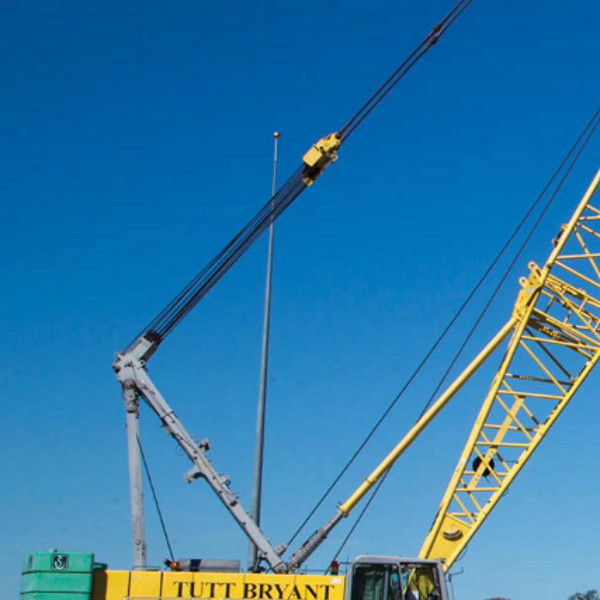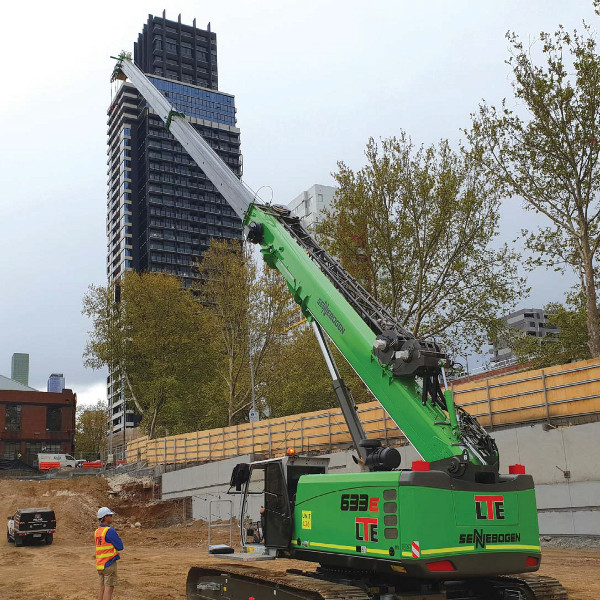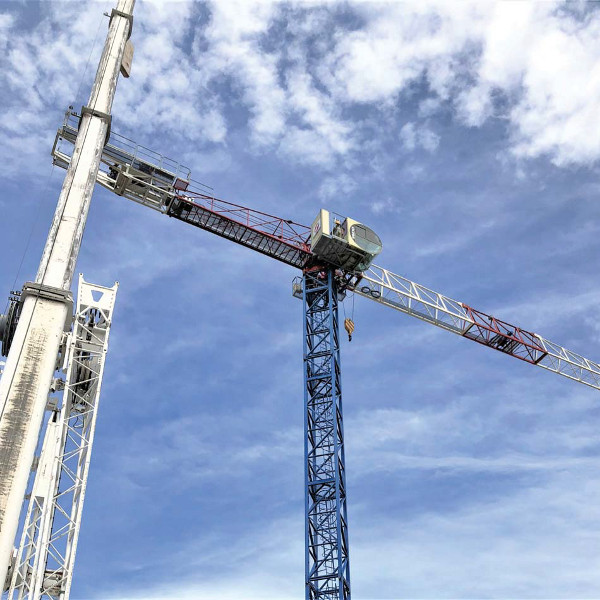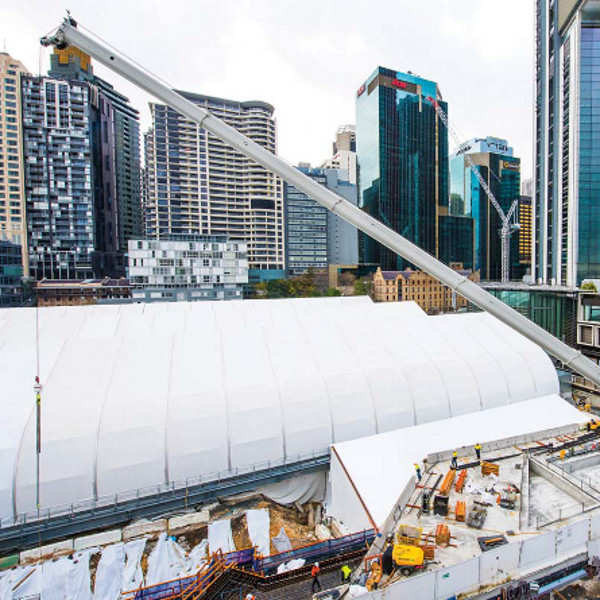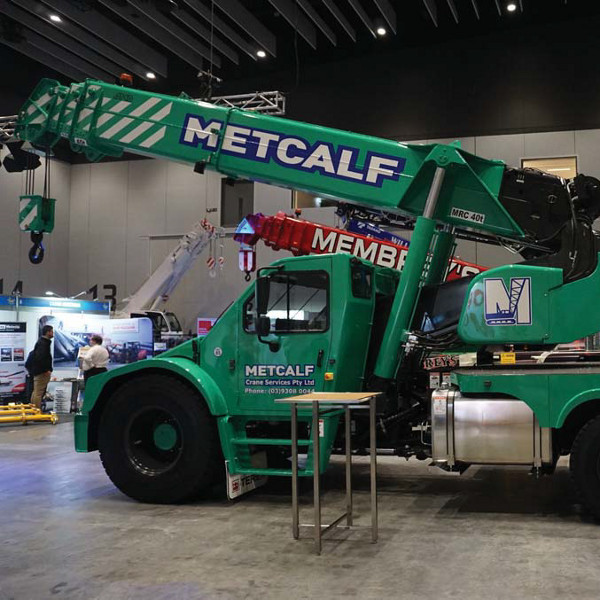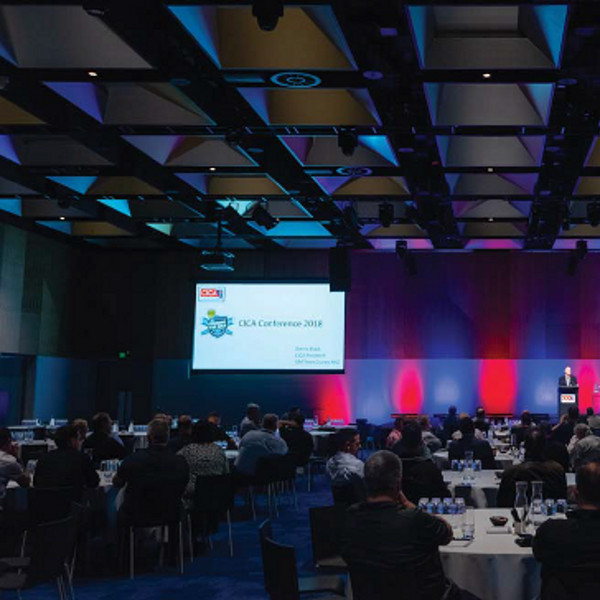Wheels in motion
18 December 2018Mobile crane orders in Australia skyrocketed this year. Combining information from a series of interviews with material from CICA’s annual conference sessions, Sotiris Kanaris looks at the state of the market for crane suppliers and hirers.
The Crane Industry Council of Australia (CICA) held its annual conference at the Melbourne Convention and Exhibition Centre on 17–19 October.
This year 500 CICA delegates attended the event, setting a new record. The high level of interest in the event is unsurprising, considering that the crane industry has been performing well and it is now preparing itself for an even bigger growth.
In the beginning of the decade, the mining construction boom kept the crane industry active. “The Western Australia mine construction boom slowed in 2013, but the downturn was not as severe as it might have been due to an increased focus on infrastructure projects in the East of the country, especially in New South Wales and now Victoria,” says Neil Hollingshead, sales director for mobile cranes at Manitowoc Crane Group Australia.
After a few years of decline, in 2017 the construction growth exceeded expectations and achieved a 5% growth. “This year it is forecasted to be around 9%,” says CICA president Danny Black. He attributed the expansion in construction activity to major infrastructure projects.
In order to meet the increased demand for their machines, crane rental companies started investing in their fleet. CICA recorded the number of crane units that went into the market from January to August and found a 76% year-on-year growth in all terrain units and 60% in pick and carry crane units.
Wheels of fortune
For all terrain cranes, manufacturers have received orders for units across a wide range of capacities. The most notable recent order in the country is the 1200t Liebherr 11200-9.1 from Max Crane & Equipment Hire, which will be the largest all terrain crane owned and based in Australia.
The best selling all terrain cranes in the market according to local suppliers are in the range of 55t to 250t.
Manitowoc’s most popular all terrain crane in Australia is now the five-axle, 150t GMK5150L. “It is proving very popular replacing the old 130t class. Manitowoc is first to the market with a 150 tonner in this class and it has revolutionised the market,” says Hollingshead.
The GMK5250L, which was on display at the CICA conference, has also been very popular since its launch. Recently one unit of this model was sold to Perth-based Kwik Logistics by Manitowoc dealer WATM Crane Sales and Services.
Australian Crane & Machinery (ACM) is introducing a new all terrain brand to the market. The company has become the exclusive dealer for Zoomlion all terrain cranes in the country and during the event it showcased the five-axle 150t ZAT1500.
Hannah Prouse, executive assistant at ACM, says these cranes undergo changes in order to meet the standards and requirements of the Australian market. Changes include tyres and CPU.
ACM’s managing director Ben Potter visited the factory in China and was impressed by the production process and the quality of the components, many of which come from Germany. He said that in the past when they represented another Chinese brand there were reliability issues, but highlighted that Chinese cranes have advanced so much technologically that now their performance is comparable to Western brands.
Prouse believes that there is a market for the Zoomlion cranes in Australia. She praises the roadability of the machines and adds: “There is so much construction going on at the moment that allows some small players to enter the market. This is a great crane to break into the market with, and it is very competitively priced.”
Link-Belt has recently launched the 150t five-axle 175|AT all terrain. Anthony Davis, managing director of Crane Connection—Link-Belt’s distributor in Australia—says the company intends to offer the new crane to the market.
“It competes well against the opposition. It has a 60m boom, full width cabin, luffing fly, and roadability is very good. You will be able to drive around the country with that machine which is a big advantage. It is a single engine machine, which keeps the weight down. It only has 37t of counterweight which is a lot less counterweight to transport than the competitive products,” says Davis.
The most successful Link-Belt crane line in Australia is the rough terrain one, more specifically cranes with maximum capacities of 80t to 100t, as many of them are being used in the mining sector. He added that they have also sold a number of the larger 145t machines.
Tadano Oceania was established nine years ago, but the Japanese manufacturer has been present in the market since the 1990s, gaining a high market share of the rough terrain market.
“Tadano has invested heavily in Australia over the last four years, it has set up a huge service and support network,” says Anthony Grosser, general manager at Tadano Oceania. The Japanese manufacturer has designed cranes specifically for the Oceania market, like the new GR-200EX rough terrain.
“Boasting an array of new features, the latest technology and the tightest swing radius in its class, this tight-access 20-tonne class machine is sure to please,” the manufacturer said when it launched the product earlier this year.
Grosser says this model is prepared from Japan for Australian weather conditions and has a Euro 4 engine. There are two models in the City Class range, a 13t and a 20t. “Many customers have moved to the 20t, but the 13t still has its place in applications such as smaller steel erection and airconditioning unit installations.”
The Japanese manufacturer has seen its truck crane line being well received in Australia. There is a 30t and 60t model available, with the demand for the latter being concentrated mostly in Western Australia and Queensland.
“These are designed for the Australian market, they can drive anywhere in the country as they come in,” Grosser adds.
Crane Connection also sells Link-Belt truck cranes, having already delivered around a dozen of the 85t units. “The strength of the US dollar is affecting pricing at the moment, if the currency improves the truck cranes will make a resurgence again. The manufacturer has launched some new models that will suit this market, like the new 100t truck crane with a 50m boom,” says Davis.
Telecrawlers on the rise
Davis has seen an increase in the popularity of telescopic crawler cranes in Australia. Crane Connection delivered a 127t TCC1400 to Sydney-based Melrose Cranes and Rigging approximately five months ago, and it is currently working at the construction site of a new casino.
“Because of the popularity of that machine and its boom length being the longest by far in its class, we have decided to have a TCC1400 in stock in Sydney for immediate delivery,” says Davis.
Pace Cranes is the Australian/ Pacific distributor of Sennebogen Cranes. There are currently 70 Sennebogen units operating in Australia, predominantly telescopic crawlers.
Anthony Heeks, managing director at Pace Cranes, says they have sold units from all the capacity classes, but the most popular unit is the 40t 643. This model is mainly used for piling and foundation work, mine construction and noise barriers. “It has very small footprint compared to a large AT. The main benefit of these cranes of course is that they are able to pick and carry,” says Heeks.
ACM has been a long-standing Kobelco distributor, and from last year the company is offering 55t and 75t telescopic crawlers. Overall the most successful Kobelco crawler in Australia is the 250t.
Potter says: “The new 300t crane is coming with some really good transport options and lifting chart performances. I think it will replace the 250t crane which has been the dominant from Kobelco over the last ten years.”
HSC Cranes are represented in the country by Tutt Bryant Equipment, part of Tutt Bryant Group which this year celebrates 80 years in business. The HSC range includes crawlers from 55t up to 600t, but the most popular capacities have been the 150t and 275t.
“It has been very quiet for a period of probably five-seven years and it has just started to pick up now. In the last six months, we have noticed an increase in sales,” says Ian Eyres, national product manager at Tutt Bryant Equipment.
Pick and carry evolution
The most characteristic crane product of Australia is the pick and carry crane, with many designed and manufactured in the country. These versatile machines are being used in various applications including mining, infrastructure work, as well as oil and gas.
The market for this type of machines is very active, with manufacturers launching new products in the past year. Looking at the new cranes, there is a clear trend towards higher capacity units.
At the CICA event, Terex showcased the first production unit of the Terex Franna AT 40. This model has 40t maximum capacity at 1.2m radius on lug and a 19m maximum hook height.
Glenn Howden, tower cranes sales manager at Terex Cranes Australia, says the move to higher capacity machines is driven by safety measures, as large contractors are decreasing the charts by 25%.
The AT 40 is very different to previous models. It features hydropneumatic suspension instead of spring suspension; counterweight at the back of the boom instead of at the back of the crane; and a full width cab and the Demag IC-1 Plus control system.
Three AT 40s have been produced at the Brisbane factory and they will be on trial for a couple of months. The most popular Terex pick and carry crane is the 25t MAC 25.
In June, Terex delivered 15 new pick and carry cranes, a mix of MAC 25-4 and AT 22 models. 13 units went to customers in Australia, one was delivered to a customer in Brazil and another to a customer in South Africa. The manufacturer says June was one of the company’s highest production months since 2014.
Humma Cranes, manufactured in Western Australia by DRA Engineering, has recently enhanced its product portfolio with the introduction of 55t Humma UV55-25 and a new series of 35t Humma UV35-25. The new models features a hydropneumatic suspension and damping system by Hemscheidt.
Earlier this year, Australian Crane & Machinery (ACM) became a distributor for Humma cranes. “At the moment they have got an approval for road registration in Western Australia and Northern territory, and we will do some work to get the 55t approved in some of the other states,” Potter says.
Prouse expects the Humma 55 to take some work traditionally undertaken by rough terrains. “It will definitely take work off some of the bigger rough terrains, particularly in the mining industry.
At the CICA event, the manufacturer of TIDD pick and carry cranes TRT announced the launch of the 25t-capacity TIDD PC25-2. The new crane will have a 6.12m–18.65m four-section full power boom with three boom nose sheaves and 15t capacity removable Rhino hook. It will include hydraulic double acting cylinders, with an integral holding valve allowing heavy rigging to drop straight into the front chain box.
To enhance safety the manufacturer has developed the patent-pending Slew Safe. When the load moment indicator on the digital display turns red, this is an overload notification that will activate Slew Safe. Once activated, it will apply a number of measure: it will reduce speed of steering to 15%; make the steering harder with feedback through the steering wheel to operator; the engine will ‘load up’, making an audible sound change for operator; there will be an audible contact alarm inside and outside the cabin; and it will retain the ability to move back to safe operation zone.
Slew Safe will be available in the TIDD PC25-2, but can be retro fitted to the previous generation model TIDD PC25.
The TIDD PC25-2 will be in the market in early 2019, with the first deliveries expected in March or April.
Robert Carden, director at TRT, is very optimistic for crane sales in the near future. “We see the market here has had a dramatic change. From being a market that was shrinking over the last four years and a lot of cranes being sold outside Australia as second hand cranes, to now being one with a shortage of cranes in the next little while. And with all the infrastructure work that is required in the country and mining maintenance coming back on the stream we see it being very buyoant in the next few years.”
Luffers on the rise
The skyline of the major Australian cities has changed a lot in the past decade, with the increased construction of high rise buildings. In the centre of Melbourne, where the CICA conference was taking place, you could see huge apartment blocks under construction.
In many of the job sites, large Favelle Favco cranes were erected, expectedly as the company has always been a strong player in the market. Chinese tower crane companies have also penetrated the market, gaining a significant share.
Western tower crane companies are making their own efforts to boost their presence in the country.
Liebherr Tower Cranes division has recently acquired crane rental and sales companies Morrow Australia and New Zealand. The Australian sales and service company of the Liebherr Group will on 1 January 2019 take over the business activities—including all the employees and locations —of Morrow Equipment in Sydney, Brisbane and Wellington.
Marco Guariglia, managing director of the Liebherr tower cranes division, said: “We are convinced that we will successfully shape the future with the entire staff at all locations, and in the interest of our customers.”
Another European company that it is trying to establish itself in the market is Jaso. As featured in the ‘Job of the month’ section of the October issue, a 700tm Jaso J780PA electric luffer is used for the construction of Grocon’s new Darling Harbour development, The Ribbon.
Luffers are becoming increasingly popular in the Australian market, particularly in the big urban centres in the East side of the island. “The slewing over neighbouring properties has become a bit of an issue for the traditional flat top, that is why luffers are becoming the norm. It is because of how you can park them as well,” says Terex’s Howden.
The CTL luffing jib tower crane range is the most demanded among the different Terex tower crane series, with five CTL260s delivered in Melbourne only recently.
Howden is excited about the new Terex tower cranes, especially the CTT202 flattop city tower: “It is a great crane because it is on the small tower. The 1.6m tower is great for us, because until now the smallest tower we had was 2.1m.”
At Manitowoc, they are seeing more enquiries for luffers as opposed to hammerheads, according to Andrew Gray, sales manager at Manitowoc Cranes Australia. “One reason for this is [overflight] trespassing, which is a big issue in Victoria and it is becoming an issue in Sydney and Brisbane.” The most popular Potain luffer in Australia is the MR 418.
“There is the new hydraulic luffing crane MCH 125, that is becoming very popular, we have ten in Sydney now. We also see that over the next two-three years there will be quite a few units of the new MCH 175 in the market.”
The best-selling small Potain topless cranes are the MCT 88 and MCT 85, while for the larger topless tower cranes is the MCT 205.
Gray says there are a lot of Potain cranes in New South Wales. Active Hire, Potain’s number one customer in Australia, is based there.
Strictly Cranes, which represents Italian tower crane manufacturer Raimondi Cranes, is also based in New South Wales.
“Strictly Cranes now has 90 cranes at work in Australia, concentrated primarily in NSW. Outside of our territory, which covers everything but Victoria, I would estimate that there are at least 80 Raimondi cranes at work,” says Ramey Alkhoshaibi, founder and commercial director, Strictly Cranes.
The company executes a Crane Management Program that allows clients to generate rental revenue from Raimondi cranes purchased in the past. As part of the programme, Strictly Cranes sources jobsites for previously-sold cranes and then handles the entire rental process including installation, maintenance, and dismantle.
The company finds the most popular models for hire are the Raimondi MRT152 and the MRT159, both 8t or 10t lifters. In terms of sales, the MRT84 has proven attractive to our clients. “We attribute this popularity to the fact that the common size residential project in New South Wales is averaging between five to seven floors,” Alkhoshaibi explains.
The company has identified a change in demand in recent years. “We did see a surge in demand for the bigger 10t hammerhead cranes due to many builders turning to precast panels rather than conventional style builds. In recent months, the luffer has had high demand. The Raimondi luffing LR213 has been really well received, and we put a few to work right when they arrived. We have yet to commission a Raimondi LR330, but we anticipate that happening early next year.”
Alkhoshaibi says the last few years have been some of Australia’s best in terms of developments springing up. However the market is expecting the market demand to change, says Gray: “High rise residential construction is slowing down; it is the reason why the demand for new tower cranes is falling.”
Growth and challenges
On the contrary to the tower crane market, the mobile crane market is forecasted to expand significantly in the next ten years, because of a series of major infrastructure and construction projects in the pipeline.
There will be billions of dollars of investments in railways, roads, stadiums, tunnels and mining construction. Unlike other growth periods were activity was concentrated in one region or state, this time the projects are spread all over the country.
A number of industry professionals that Cranes Today talked to expressed fear of a crane shortage in the country in the coming years.
With the expectation of a demand surge, crane suppliers are boosting their stock.
Pace Cranes’s Heeks says: “We need to make sure we have the right models in stock, but getting those models out of the factories is quite hard because the rest of the world is growing quite strong. We have 25 Sennebogen and Maeda cranes on order at the moment, which will be arriving throughout the next four months.
Tutt Bryant expects a further increase in HSC Crane sales, and for the first time in many years the company has a stock of crawler cranes. In stock are units of the SCX1500A-3 model.
The crane hire companies are already facing challenges in Australia, which may get exacerbated in the near future.
“The market remains tight with pricing below what we would all like it to be,” says Rob West, general manager at Tutt Bryant Heavy Lift & Shift. This might continue as there are new small players entering the market, which will try to earn business.
Problems also arise from the increased popularity of wet hire over the last couple of years. “I think this is related to: smaller projects and them being in capital city markets increasingly meaning local companies with the skills can supply; the heavy regulation of the labour market in Australia and high labour costs stemming from that; and our clients changing the risk profile favouring placing the responsibility to the crane owners,” says West.
Greg Lee, managing director at Lee Crane Hire, says a lot of clients want the company to supply them with its experienced operators but they want to pay a dry hire rate. He adds that many times contractors refuse to get their own operators.
Another major problem for the industry is the difficulty to attract talent, with a general fear of a labour shortage in the near future.
West adds: “With the projected increased activity within mining in Western Australia, the skills shortage experienced in the last boom will be repeated and probably more intensely, as a lot of the fly in fly out workforce used in the last boom were Sydney and Melbourne-based while those cities experienced quiet times. With the levels of activity in those cities, that market will likely dry up, meaning the workforce will be harder to find. Increased industrial activity is also a major concern for the market.”
Despite the challenges, West is optimistic about the near future: “The outlook is certainly more positive and we anticipate better results from that.”
Over the next decade, the Australian crane market will change significantly. The number of cranes and competition will increase, while there will be a need for new workers to enter the industry and train. The local industry players are rolling up their sleeves in order to be prepared for any challenges and reap the benefits of this boost in business activity.
